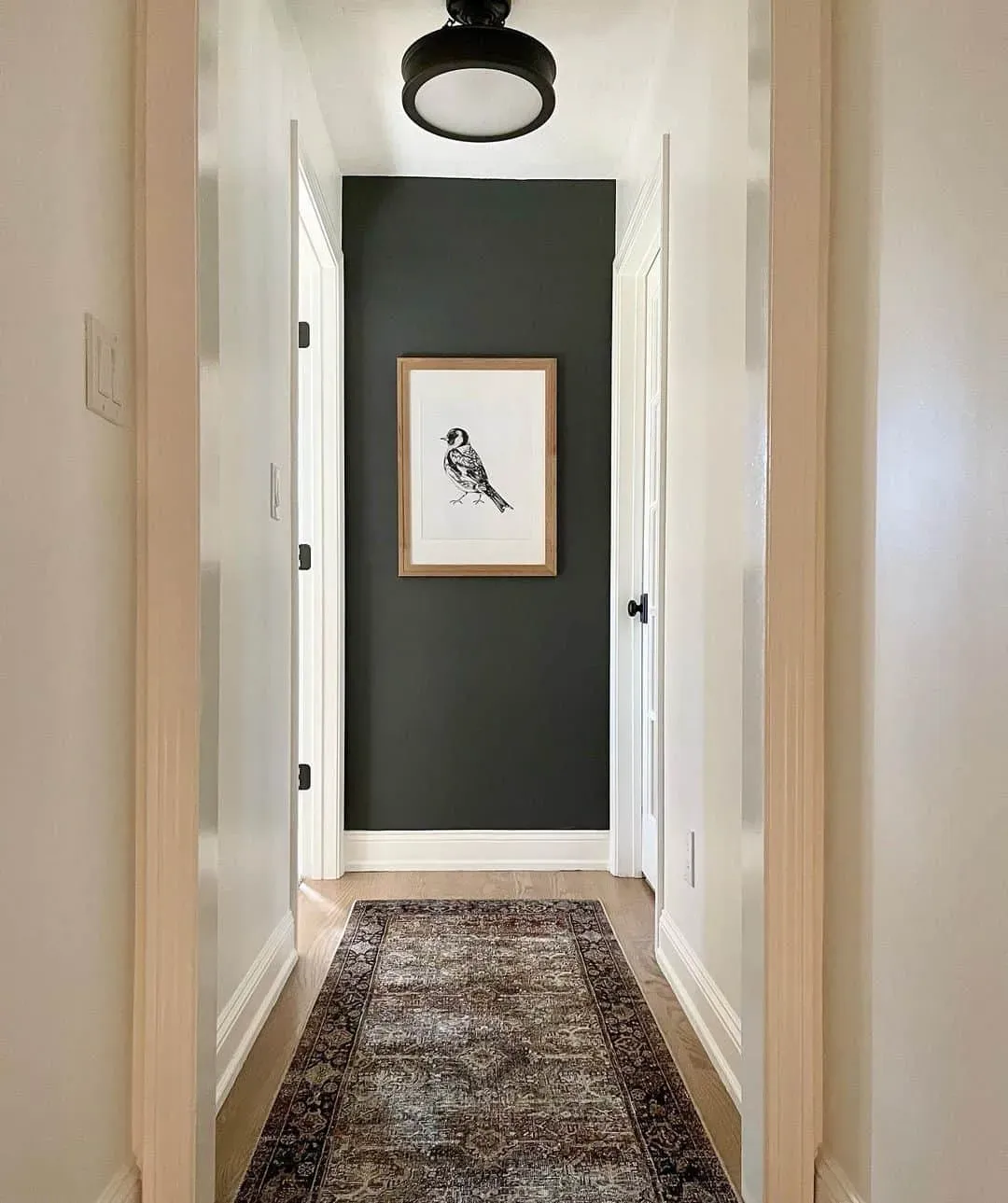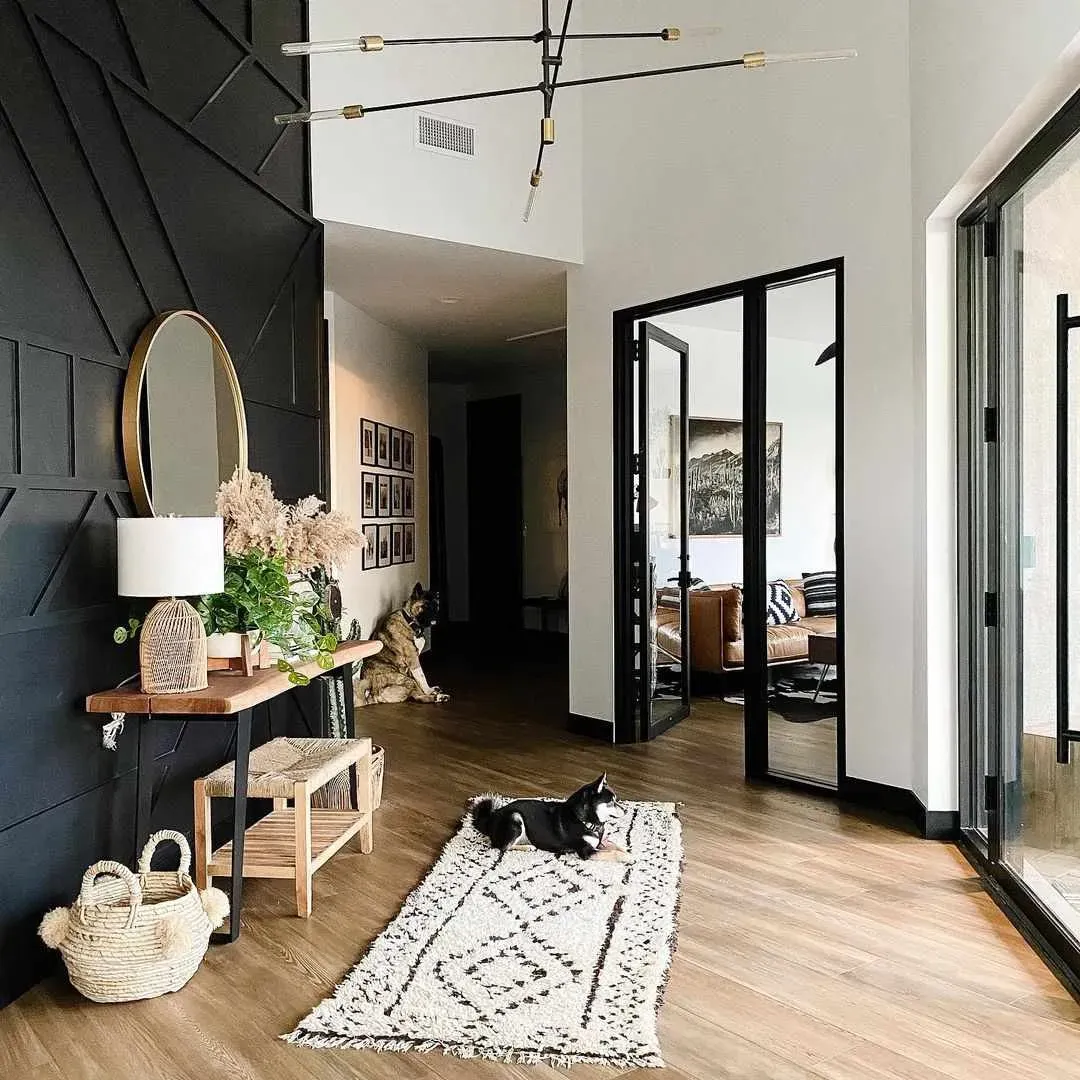Table of Contents
Thinking about painting your hallway? Most folks reach for beige or light gray, hoping to make the space feel bigger. Safe choices, sure. But let's be real, hallways are often overlooked passages, not destinations. What if you flipped the script entirely?
The Bold Statement: Why Choose a Black Accent Wall Hallway?

The Bold Statement: Why Choose a Black Accent Wall Hallway?
Beyond Beige: Ditching the Default
Let's face it, hallways are often the neglected stepchild of home design. They're the transition zones, the places you pass through on your way to somewhere else. Because of this, the default setting for walls is usually something light and neutral – greige, off-white, maybe a pale blue if you're feeling wild. The logic is simple: make it feel bigger, brighter. But does "bigger and brighter" always equal interesting or memorable? Usually not. Ablack accent wall hallwayimmediately tells a different story. It's a deliberate choice, a signal that this isn't just a connector space; it's part of the home's personality.
Creating Instant Drama and Depth
Painting one wall black in a hallway isn't about making the space feel small and gloomy, despite what conventional wisdom might scream. It's about creating a focal point, adding depth, and injecting a serious dose of sophistication. Think of it like adding a sharp, dark suit to a wardrobe of khakis and polos. Suddenly, everything else looks a little more intentional. A black wall can make artwork pop, frame a console table beautifully, or simply draw the eye down the hall, making the space feel longer and more dynamic than a uniformly painted corridor ever could.
Why Go Black in the Hallway?
- It creates a strong first impression.
- It makes adjacent colors and decor stand out.
- It adds perceived depth to a narrow space.
- It provides a sophisticated, gallery-like backdrop.
- It elevates the overall design aesthetic.
Setting the Tone for Your Home
Your hallway is the first interior space guests see when they step inside. It’s the handshake of your home. What does a pale, unassuming hallway say? "Welcome, I suppose." What does a hallway with a striking black accent wall say? "Step inside. Something interesting is happening here." It sets an expectation, a mood. It signals confidence in design choices and hints at the style that awaits in the rooms beyond. It's an anchor point, grounding the space and providing a visual pause before the rest of the house unfolds.
Picking the Perfect Hue: Not All Black is Equal for Your Hallway

Picking the Perfect Hue: Not All Black is Equal for Your Hallway
Beyond Just "Black": Understanding Undertones
you've committed to theblack accent wall hallway. Great. Now stand in front of the paint chips, and suddenly you realize there are fifty shades of... well, not gray, but definitely not just one black. This is where things get interesting. Black isn't just black. It has undertones. These subtle hints of color lurking beneath the surface make a massive difference in how the paint looks on your wall, especially in the varying light of a hallway. Is it a cool black with blue or green undertones? A warm black with hints of brown or red? Or a true, neutral black?
Sampling is Non-Negotiable
Ignoring undertones is like ordering a coffee "black" and getting a latte – technically a coffee drink, but not what you expected. A cool black might feel crisp and modern, pairing well with grays and blues. A warm black can feel cozier, working better with wood tones and warmer whites. The only way to know how a specific black will behave in *your* hallway, with *your* lighting (both natural and artificial) and *your* existing finishes, is to sample it. Paint large swatches on the wall you plan to accent. Look at them at different times of day. See how the light changes the color. This step prevents a costly mistake and ensures the black you choose adds sophistication, not just gloom.
Common Black Paint Undertones:
- Blue (cool, crisp)
- Green (can feel earthy or inky)
- Brown (warm, softer)
- Violet (subtle, can add complexity)
- Neutral (true black, less common)
Decorating Your Black Accent Wall Hallway: Making it Pop

Decorating Your Black Accent Wall Hallway: Making it Pop
Artwork and Mirrors: Giving the Wall a Job
So you've got yourblack accent wall hallway. It's bold, it's dramatic, but an empty black wall can feel a bit... flat. This is where art and mirrors come in. Think of the black as the ultimate gallery wall backdrop. Bright, colorful art practically vibrates against it. Black and white photography gets a serious boost in sophistication. Don't just hang one small picture; go for impact. A large statement piece or a curated gallery wall turns the wall into a destination. Mirrors, on the other hand, break up the black expanse, bounce light around (crucial in a hallway), and can make the space feel a little less enclosed. A large, decorative mirror can be just as impactful as a piece of art.
Console Tables and Furniture: Anchoring the Space
A black accent wall provides a fantastic anchor for furniture. A slim console table placed against it instantly creates a vignette. This isn't just a place to drop keys; it's an opportunity to style. Think about adding a lamp for ambient light, a small plant for a touch of life, or a stack of interesting books. The black wall makes whatever you place in front of it stand out. Choose furniture with contrasting finishes – light wood, metal, or even a pop of color – to prevent everything from blending together. It's about layering elements to create visual interest.
Decor Elements for a Black Accent Wall:
- Brightly colored abstract art
- Large, ornate mirrors
- Slim console tables (wood, metal, or painted)
- Table lamps for layered light
- Vases with greenery or flowers
- Curated stacks of books or decorative objects
- Floating shelves with small sculptures or framed photos
Layering Textures and Metals: Adding Sparkle and Depth
To keep the black from feeling one-dimensional, layer in different textures and metallic finishes. A rough-hewn wood console, a plush rug runner, or textured wallpaper panels applied to sections of the black wall can add tactile interest. Metallics like gold, brass, or even polished chrome pop beautifully against black. Use these in picture frames, lamp bases, mirror frames, or decorative objects on your console table. These reflective surfaces catch the light and add a touch of glamour, ensuring your black accent wall hallway feels sophisticated and dynamic, not just dark.
Lighting Up Your Black Accent Wall Hallway: Banishing the Gloom

Lighting Up Your Black Accent Wall Hallway: Banishing the Gloom
Strategic Illumination: More Than Just a Lightbulb
the biggest fear with ablack accent wall hallway? That it's going to feel like walking into a cave. And yeah, if you just rely on one sad overhead bulb, it probably will. The secret sauce to making a black wall sing, not sulk, is lighting – and lots of it, layered strategically. You need ambient light to generally brighten the space, task lighting if there's a specific area you want to highlight (like a console table), and accent lighting to draw attention to the wall itself or the art on it. Don't just think about brightness; think about *where* the light hits and *how* it interacts with the black surface. It's the difference between a sophisticated lounge and a dungeon.
Beyond the Paint: Adding Texture and Art to Your Hallway Design

Beyond the Paint: Adding Texture and Art to Your Hallway Design
Giving the Black Wall Some Tactile Interest
A flat black wall can be sleek, sure, but it can also feel a bit... flat. Like a void. To combat this and add another layer of sophistication to yourblack accent wall hallway, think texture. This doesn't mean you have to re-wallpaper the whole thing, though textured wallpaper is definitely an option. Consider applying molding – simple picture frame molding creates a paneled look that adds architectural interest and catches light differently. Reclaimed wood planks, shiplap (yes, even painted black), or even a Venetian plaster technique can give that wall a tactile quality that makes you want to reach out and touch it. It adds depth beyond just the color itself.
Ways to Add Texture:
- Apply molding (picture frame, board and batten)
- Install textured wallpaper (grasscloth, subtle patterns)
- Consider wood paneling (painted black)
- Use Venetian plaster or other textured paint techniques
- Hang textiles or tapestries
Curating Your Gallery Against the Dark Canvas
Once the black is on the wall and maybe you've added some molding, it's time for the stars of the show: art and curated objects. As mentioned before, black is the ultimate backdrop. That vibrant abstract painting you love? It will sing against black. Black and white photos gain instant gravitas. Don't be afraid to mix mediums – framed prints, canvases, even sculptural pieces mounted on the wall work. Think about creating a narrative or a collection. Maybe it's all landscapes, or portraits, or a mix of abstract and figurative. The key is thoughtful placement and variety in size and frame style. This isn't just hanging stuff; it's building a gallery that reflects your taste and gives people something to look at as they move through the space. A well-dressed black wall is far more than just paint.
The Final Word on Black Hallways
So, you've considered the dark side of design for your hallway. A black accent wall isn't a magic bullet for every space, but it undeniably shifts the energy of a corridor from mere passage to deliberate design moment. It demands attention, provides a stark backdrop for art or furniture, and when executed thoughtfully with proper lighting and complementary elements, it avoids feeling like a forgotten corner. It's a commitment, sure, but one that pays off by turning an often-ignored area into a memorable part of your home's narrative.
